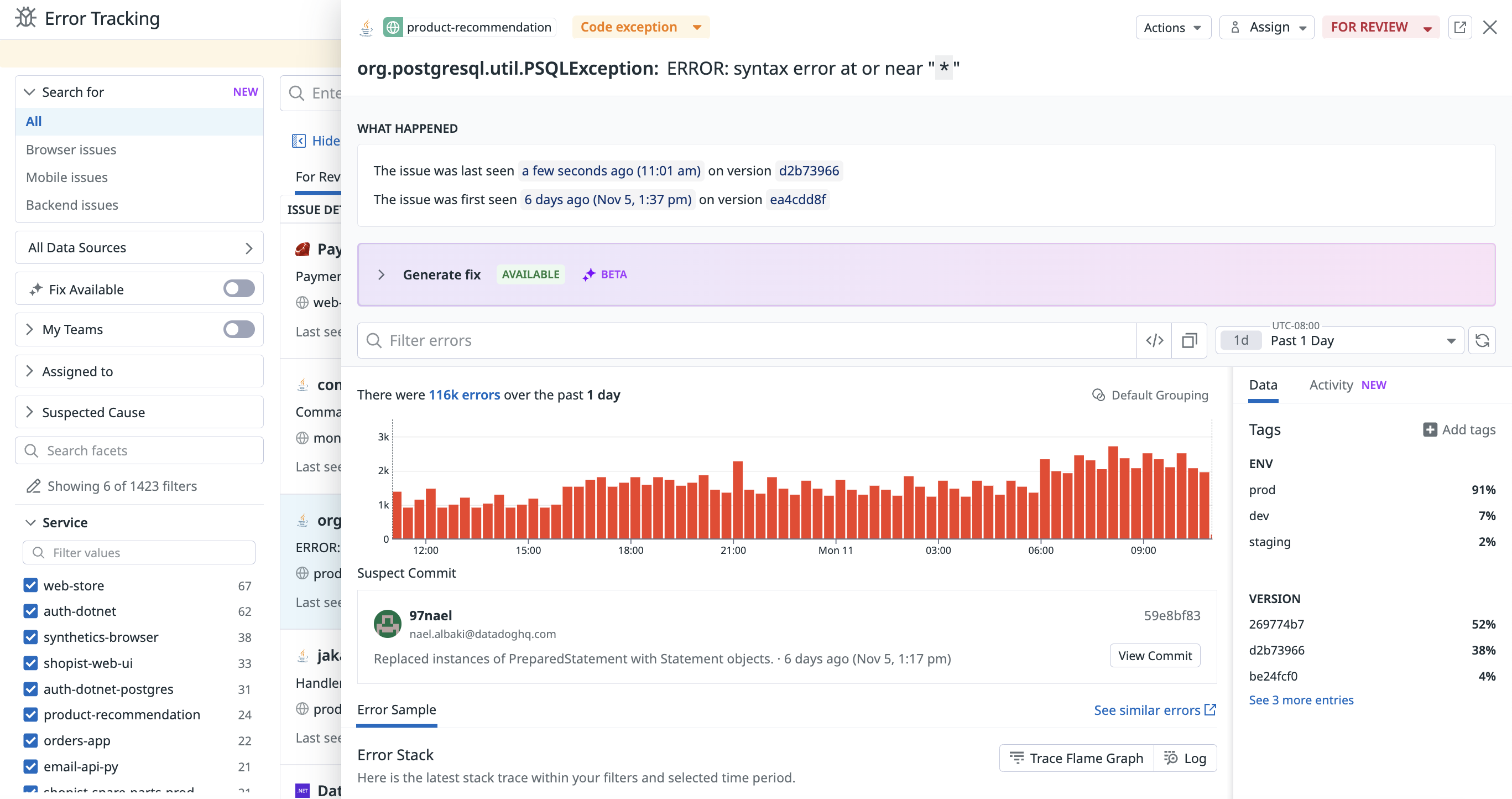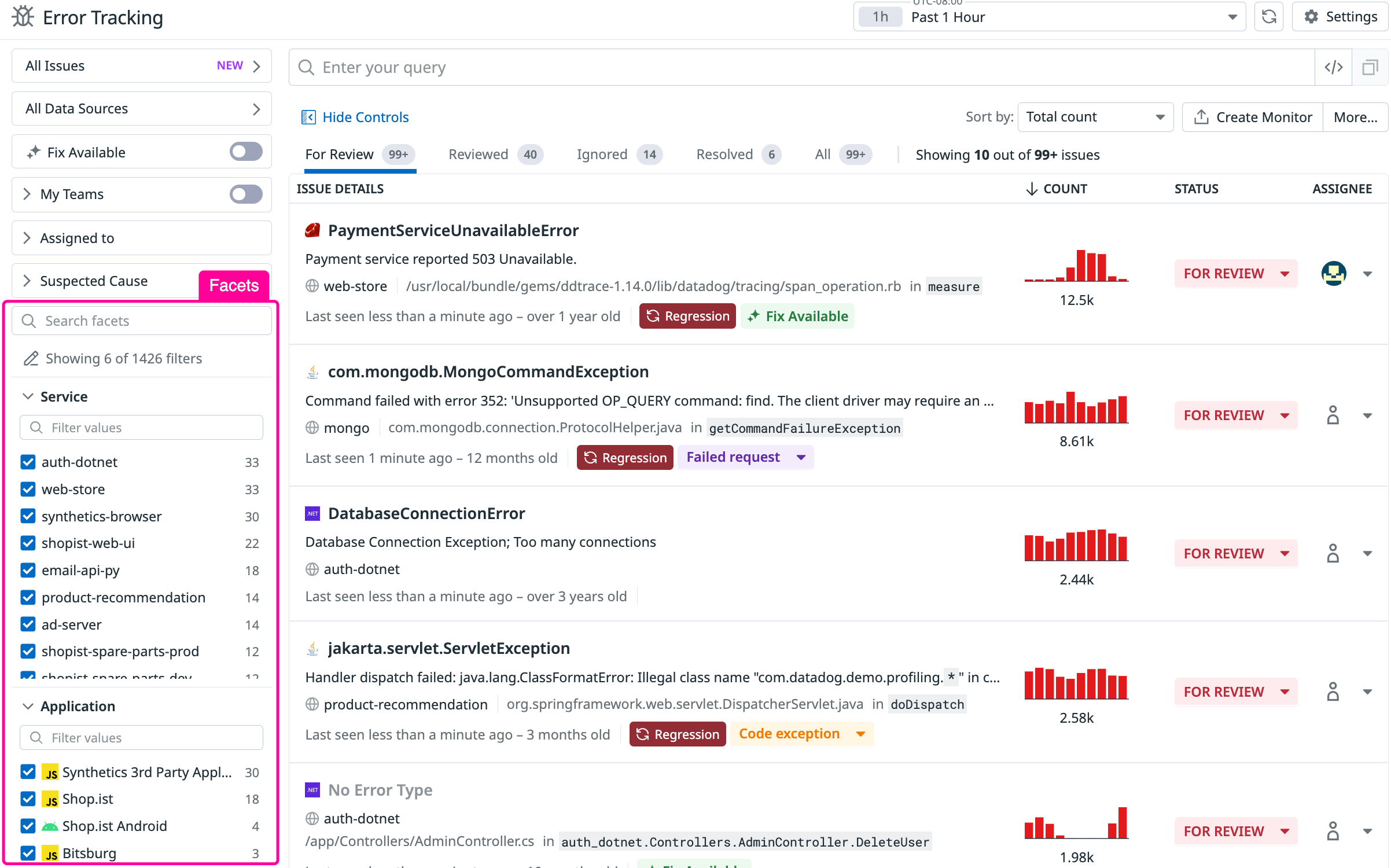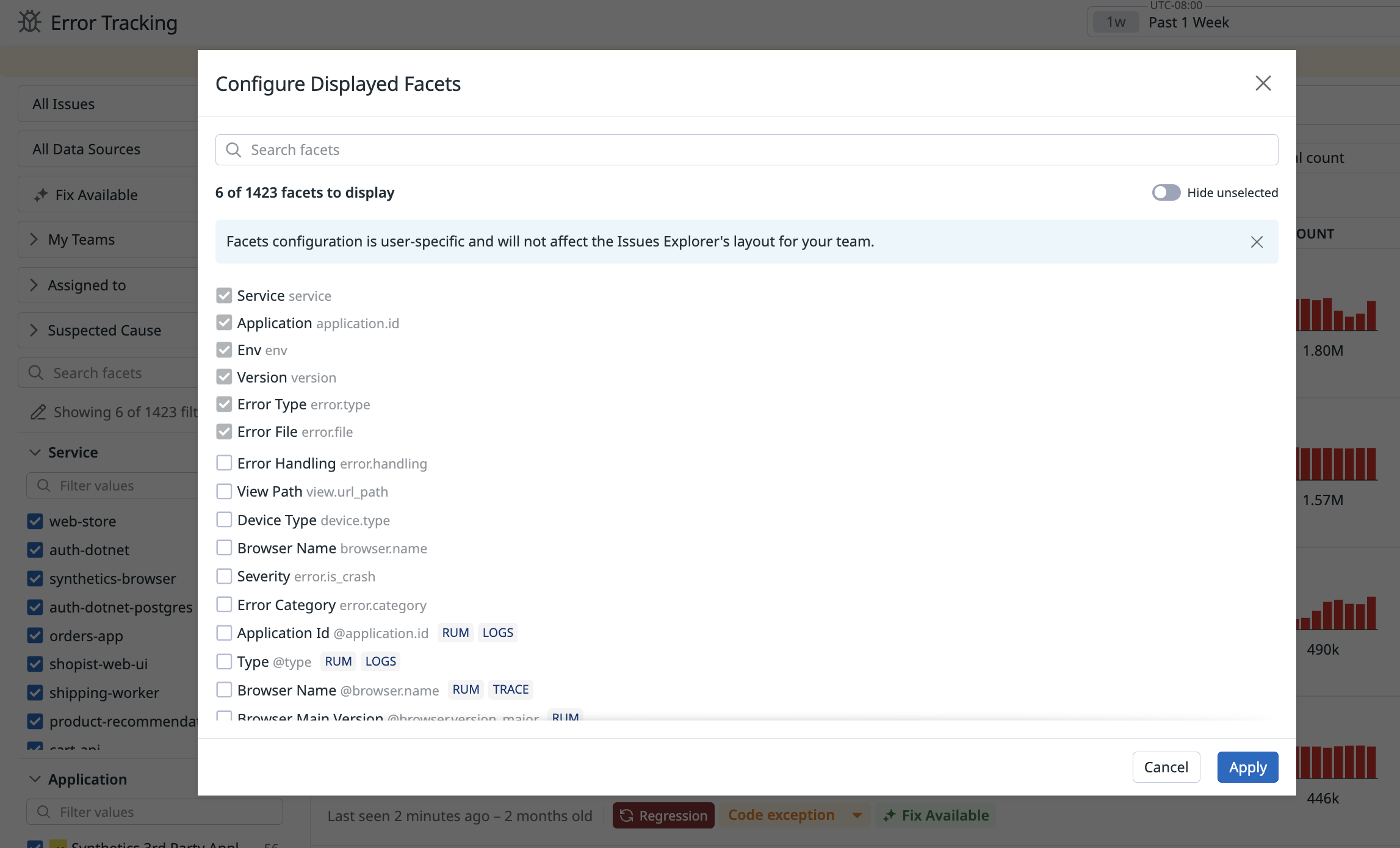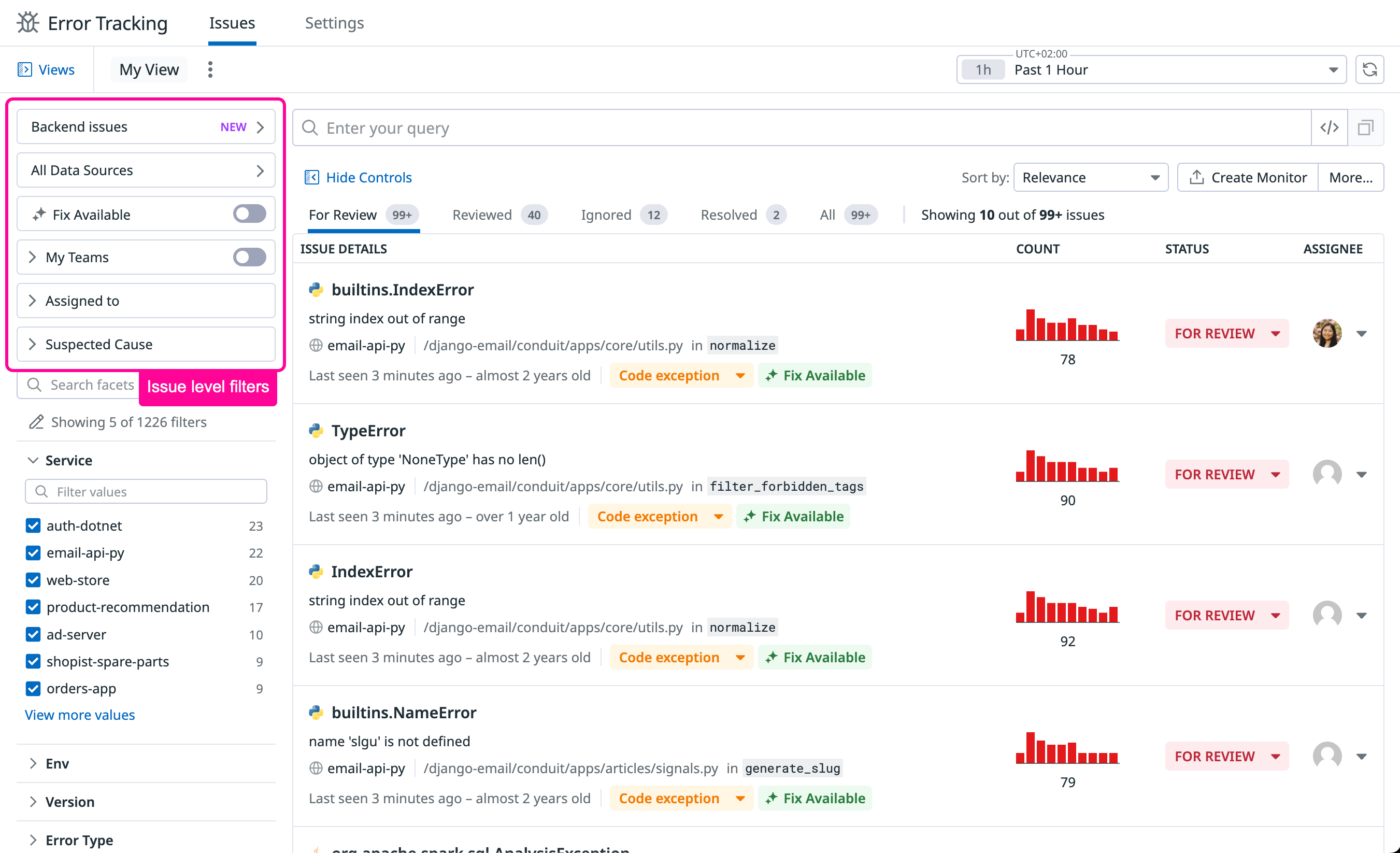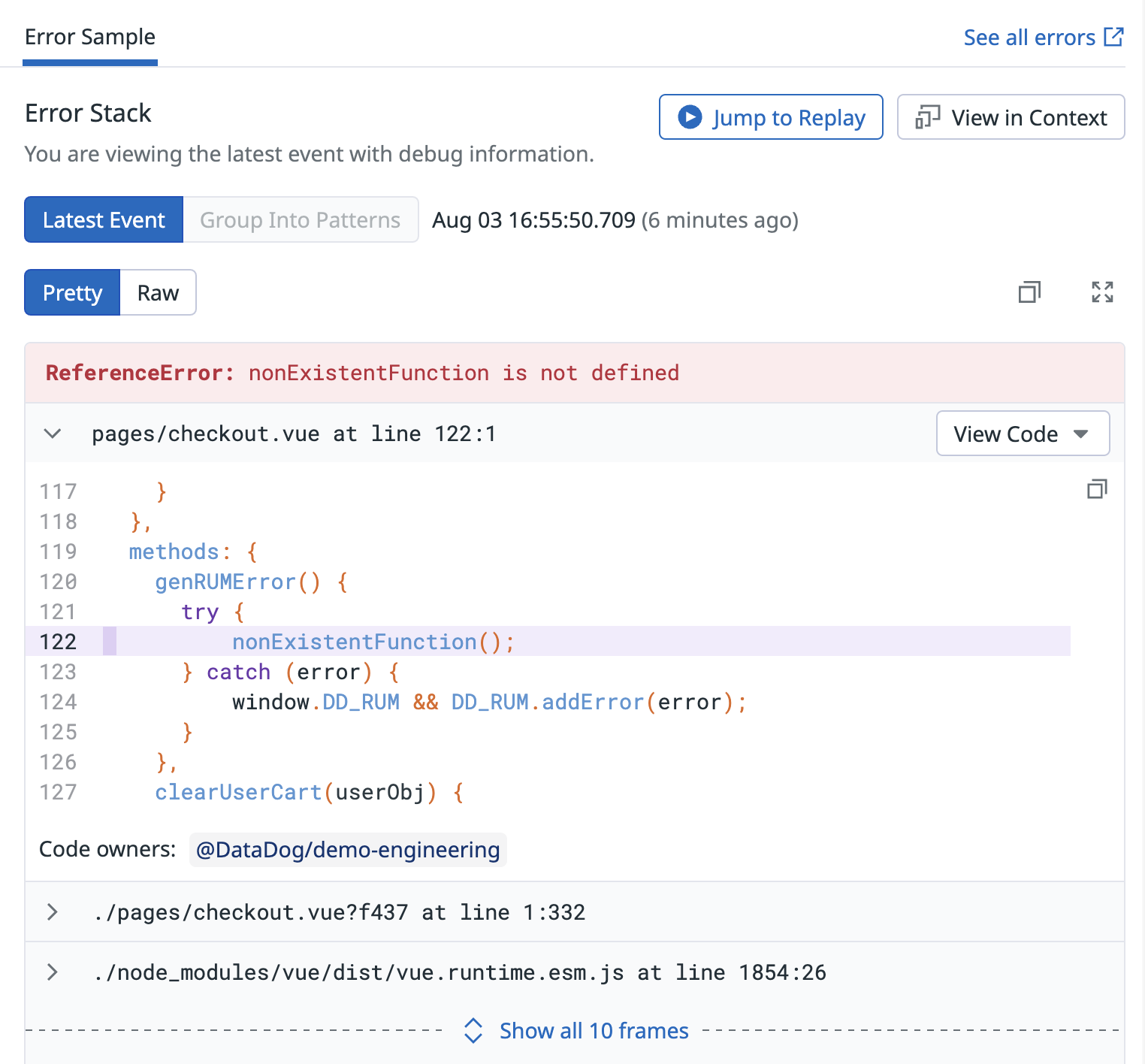- Esenciales
- Empezando
- Agent
- API
- Rastreo de APM
- Contenedores
- Dashboards
- Monitorización de bases de datos
- Datadog
- Sitio web de Datadog
- DevSecOps
- Gestión de incidencias
- Integraciones
- Internal Developer Portal
- Logs
- Monitores
- OpenTelemetry
- Generador de perfiles
- Session Replay
- Security
- Serverless para Lambda AWS
- Software Delivery
- Monitorización Synthetic
- Etiquetas (tags)
- Workflow Automation
- Centro de aprendizaje
- Compatibilidad
- Glosario
- Atributos estándar
- Guías
- Agent
- Arquitectura
- IoT
- Plataformas compatibles
- Recopilación de logs
- Configuración
- Automatización de flotas
- Solucionar problemas
- Detección de nombres de host en contenedores
- Modo de depuración
- Flare del Agent
- Estado del check del Agent
- Problemas de NTP
- Problemas de permisos
- Problemas de integraciones
- Problemas del sitio
- Problemas de Autodiscovery
- Problemas de contenedores de Windows
- Configuración del tiempo de ejecución del Agent
- Consumo elevado de memoria o CPU
- Guías
- Seguridad de datos
- Integraciones
- Desarrolladores
- Autorización
- DogStatsD
- Checks personalizados
- Integraciones
- Build an Integration with Datadog
- Crear una integración basada en el Agent
- Crear una integración API
- Crear un pipeline de logs
- Referencia de activos de integración
- Crear una oferta de mercado
- Crear un dashboard de integración
- Create a Monitor Template
- Crear una regla de detección Cloud SIEM
- Instalar la herramienta de desarrollo de integraciones del Agente
- Checks de servicio
- Complementos de IDE
- Comunidad
- Guías
- OpenTelemetry
- Administrator's Guide
- API
- Partners
- Aplicación móvil de Datadog
- DDSQL Reference
- CoScreen
- CoTerm
- Remote Configuration
- Cloudcraft
- En la aplicación
- Dashboards
- Notebooks
- Editor DDSQL
- Reference Tables
- Hojas
- Monitores y alertas
- Watchdog
- Métricas
- Bits AI
- Internal Developer Portal
- Error Tracking
- Explorador
- Estados de problemas
- Detección de regresión
- Suspected Causes
- Error Grouping
- Bits AI Dev Agent
- Monitores
- Issue Correlation
- Identificar confirmaciones sospechosas
- Auto Assign
- Issue Team Ownership
- Rastrear errores del navegador y móviles
- Rastrear errores de backend
- Manage Data Collection
- Solucionar problemas
- Guides
- Change Tracking
- Gestión de servicios
- Objetivos de nivel de servicio (SLOs)
- Gestión de incidentes
- De guardia
- Status Pages
- Gestión de eventos
- Gestión de casos
- Actions & Remediations
- Infraestructura
- Cloudcraft
- Catálogo de recursos
- Universal Service Monitoring
- Hosts
- Contenedores
- Processes
- Serverless
- Monitorización de red
- Cloud Cost
- Rendimiento de las aplicaciones
- APM
- Términos y conceptos de APM
- Instrumentación de aplicación
- Recopilación de métricas de APM
- Configuración de pipelines de trazas
- Correlacionar trazas (traces) y otros datos de telemetría
- Trace Explorer
- Recommendations
- Code Origin for Spans
- Observabilidad del servicio
- Endpoint Observability
- Instrumentación dinámica
- Live Debugger
- Error Tracking
- Seguridad de los datos
- Guías
- Solucionar problemas
- Límites de tasa del Agent
- Métricas de APM del Agent
- Uso de recursos del Agent
- Logs correlacionados
- Stacks tecnológicos de llamada en profundidad PHP 5
- Herramienta de diagnóstico de .NET
- Cuantificación de APM
- Go Compile-Time Instrumentation
- Logs de inicio del rastreador
- Logs de depuración del rastreador
- Errores de conexión
- Continuous Profiler
- Database Monitoring
- Gastos generales de integración del Agent
- Arquitecturas de configuración
- Configuración de Postgres
- Configuración de MySQL
- Configuración de SQL Server
- Configuración de Oracle
- Configuración de MongoDB
- Setting Up Amazon DocumentDB
- Conexión de DBM y trazas
- Datos recopilados
- Explorar hosts de bases de datos
- Explorar métricas de consultas
- Explorar ejemplos de consulta
- Exploring Database Schemas
- Exploring Recommendations
- Solucionar problemas
- Guías
- Data Streams Monitoring
- Data Jobs Monitoring
- Data Observability
- Experiencia digital
- Real User Monitoring
- Pruebas y monitorización de Synthetics
- Continuous Testing
- Análisis de productos
- Entrega de software
- CI Visibility
- CD Visibility
- Deployment Gates
- Test Visibility
- Configuración
- Network Settings
- Tests en contenedores
- Repositories
- Explorador
- Monitores
- Test Health
- Flaky Test Management
- Working with Flaky Tests
- Test Impact Analysis
- Flujos de trabajo de desarrolladores
- Cobertura de código
- Instrumentar tests de navegador con RUM
- Instrumentar tests de Swift con RUM
- Correlacionar logs y tests
- Guías
- Solucionar problemas
- Code Coverage
- Quality Gates
- Métricas de DORA
- Feature Flags
- Seguridad
- Información general de seguridad
- Cloud SIEM
- Code Security
- Cloud Security Management
- Application Security Management
- Workload Protection
- Sensitive Data Scanner
- Observabilidad de la IA
- Log Management
- Observability Pipelines
- Gestión de logs
- CloudPrem
- Administración
- Gestión de cuentas
- Seguridad de los datos
- Ayuda
Error Tracking Explorer
Información general
El Explorador de Error Tracking permite ver, filtrar e investigar incidentes. Un incidente es un grupo de errores similares relacionados con el mismo fallo. Datadog crea incidentes contando una huella digital por cada error, utilizando algunos de sus atributos como el tipo de error, el mensaje de error o la traza (trace) de stack tecnológico. Los errores con la misma huella digital se agrupan en el mismo incidente.
Explorar tus incidentes
Cada elemento listado en el Explorador de Error Tracking es un incidente que contiene información clara sobre el error, incluyendo lo siguiente:
- El tipo de error y el mensaje de error
- La ruta al archivo en el que se activan los errores subyacentes
- Información importante sobre la duración del incidente:
- Cuándo fue visto por primera y última vez
- Gráfico de casos a lo largo del tiempo
- Número de casos en el periodo de tiempo seleccionado
El tema también está etiquetado como:
New, si el incidente fue visto por primera vez hace menos de dos días y está en estado PARA REVISIÓN (Para revisión) (consulta Estados de incidentes)Regression, si el incidente se RESOLVIÓ y volvió a producirse en una versión más reciente (consulta Detección de regresiones)Crash, si la aplicación se bloquea- Con una causa sospechada
Rango de tiempo
El rango de tiempo aparece en la parte superior derecha del Explorador como una línea de tiempo. Esta función te permite visualizar los incidentes con errores ocurridos dentro del periodo de tiempo seleccionado. Cambia el rango de tiempo seleccionando un rango preestablecido en el menú desplegable.
Clasificación
Clasifica incidentes en la lista utilizando una de estas opciones:
- Relevancia combina varias características de incidentes para priorizar aquellos relacionados con el código, recientes o con picos de error. Error Tracking analiza la antigüedad de los incidentes, los casos del último día, el aumento significativo en la última hora o si han provocado un bloqueo de la aplicación.
- Recuento clasifica los incidentes en función del recuento total de casos en el rango de tiempo seleccionado.
- Más recientes ordena los incidentes en función de cuándo fueron vistos por primera vez.
- Sesiones afectadas ordena los incidentes por el número de sesiones RUM afectadas.
Facetas
Error Tracking indexa automáticamente una lista predefinida de atributos de tus incidentes y crea facetas a partir de ella. Una faceta muestra todos los miembros distintos de un atributo para el periodo de tiempo seleccionado y proporciona algunos análisis básicos, como el número de incidentes representados. Las facetas permiten pivotar o filtrar los incidentes en función de un atributo determinado.
Algunos de los atributos de error más utilizados son
| Atributo | Descripción |
|---|---|
error.message | El mensaje asociado con el error. |
error.type | El tipo o la clase de error. |
error.stack | La traza de stack tecnológico asociada al error. |
error.handling | Indica si el error fue gestionado. Los errores APM se consideran handled si un tramo (span) principal informa una operación exitosa (HTTP 200, gRPC OK) o una gestión de error exitosa (HTTP 400, gRPC NOT_FOUND). Los errores RUM se consideran unhandled si no se capturan manualmente en el código. |
Haz clic en el icono Edit (Editar) para ver la lista de facetas disponibles que puedes mostrar u ocultar de la vista.
Filtros de nivel de incidente
Además de los eventos de error, Error Tracking ofrece filtros de nivel de incidente para refinar la lista de incidentes mostrados.
Fuentes
Error Tracking consolida los errores de varios productos de Datadog (RUM, logs, APM) en una vista unificada, lo que te permite observar y solucionar errores en todo el stack tecnológico. En el Explorador puedes elegir mostrar Todos los incidentes, o incidentes de Navegador, Móvil o Backend.
Para un filtrado más granular, puedes limitar los incidentes por fuentes específicas de logs o por SDK y delimitarlos a un lenguaje de programación.
Parche disponible
Muestra solo los incidentes que tienen un parche generado por AI, disponible para corregir rápidamente los incidentes.
Filtros de equipos
Issue Team Ownership te ayuda a identificar rápidamente los incidentes relevantes para tu equipo mediante CODEOWNERS Git y propietarios de servicios.
Asignado a
Realiza un seguimiento de los incidentes, asígnalos a los miembros del equipo con más conocimientos y refina fácilmente la lista de incidentes por destinatario.
Causa sospechada
Causa sospechada ayuda a filtrar y priorizar los errores con mayor rapidez, lo que permite a los equipos abordar las posibles causas con mayor eficacia.
Inspeccionar un incidente
Haz clic en cualquier incidente para abrir el panel de incidentes y ver más información sobre este.
Los detalles claros que necesitas para solucionar un incidente se encuentran en la parte superior del panel. Desde allí, podrás entender su ciclo de vida: las fechas del primero y el último caso, el recuento total, así como el recuento a lo largo del tiempo para el incidente en cuestión.
La información mostrada en el panel de incidentes varía en función de la fuente del error. Por ejemplo, un incidente creado a partir de errores APM muestra etiquetas del tramo de error, como el recurso o el nombre de la operación, con acceso directo a la traza relacionada o a los logs vinculados a ella.
La parte inferior del panel de incidentes te ofrece la posibilidad de navegar por los ejemplos de error del incidente relacionado. Cada ejemplo de error ofrece información para la resolución de problemas, como la traza de stack tecnológico del error y las características de los usuarios afectados.
Recibir alertas sobre errores nuevos o impactantes
Ver un nuevo incidente en cuanto se produce te da la oportunidad de identificarlo y solucionarlo de forma proactiva antes de que se convierta en crítico. Los monitores de Error Tracking te permiten realizar un seguimiento de cualquier incidente nuevo o incidentes que tengan un alto impacto en tus sistemas o en tus usuarios (consulta Monitores de Error Tracking).
Puedes exportar directamente tu consulta de búsqueda desde el Explorador para crear un monitor de Error Tracking en el contexto relacionado:
Referencias adicionales
Más enlaces, artículos y documentación útiles:
